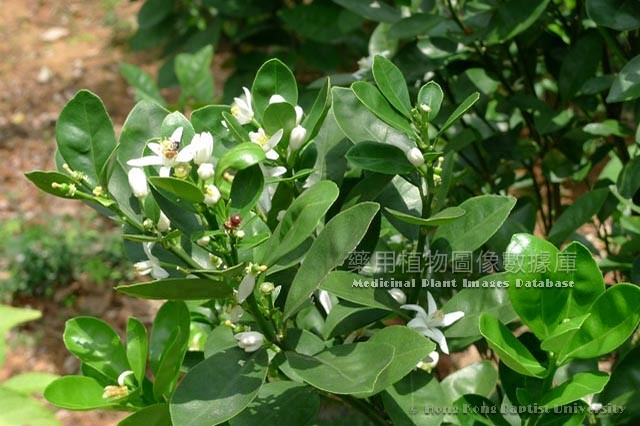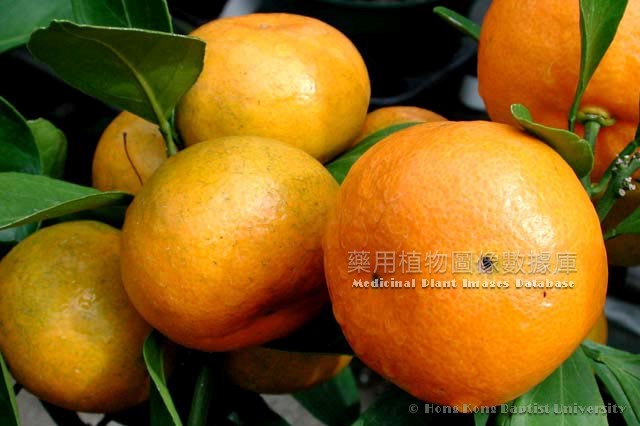|
|
|
Citrus reticulata Blanco


|
English Name |
Satsuma Orenge, Mandarin, Mandarin Orange, Orange, Pummelo Orange, Chinese Honey, Looseskinned Orenge, Ponkan Orange, Clementine, Tangerine |
|
Latin name |
Citrus reticulata Blanco |
|
Family & Genus |
Rutaceae, Citrus |
|
Description |
Evergreen small trees or shrubs, about 3m tall. Branches thin and weak, often with spines. Leaves alternate; petioles 0.5-1.5cm long, with unclear wings, top with nodes; blades coriaceous, lanceolate to oval-lanceolate, 5.5-8cm long, 1.5-4cm wide, apex acuminate, slightly concave, base cuneate, entire or with fine blunt teeth, with translucent oil spots. Flowers solitary or several flowers clustered at the end of branches or leaf axils; calyx cup-shaped, 5 lobed; flowers small, petals 5, yellow white or with pink, reflexed upward when flowers open; stamens 18-24, varying in length, filaments often 3-5 pieces connate; pistil 1, ovary round, 9-15 chambers, stigma head-like. Hesperidiums nearly spherical or flat spherical, orange or pale red yellow, 5-7cm in diameter, peel lax, easily peeled, cystigenic valves 7-12, very easily isolated, juice cells soft and juicy. Seeds ovate, white, one end pointed, several to dozens or none. Flowering: March to April, fruiting: October to December. |
|
Distribution |
Growing on hills, hilly areas, river and lake banks or plains. Can be cultivated. Distributed in Jiangsu, Anhui, Zhejiang, Jiangxi, Taiwan, Hubei, Hunan, Guangdong, Guangxi, Hainan, Sichuan, Guizhou, Yunnan and etc. The medicinal materials are mainly produced in Guangdong, Sichuan and etc. |
|
Part Used |
Medical part: mature pericarp, young fruitlets, pericarp of immature fruits, outer pericarp and mature seeds. Chinese name: mature pericarp: Chenpi; young fruitlets and their pericarp: Qingpi; outer pericarp: Juhong; mature seeds: Juhe. |
|
Harvest & Processing |
Chenpi: excavated from November to December, stripped pericarp, sun-dried or dried in low temperature. Qingpi: collected naturally fallen fruitlets from May to June, sun-dried, called "Geqingpi"; picked immature fruits from July- August, cut the pericarp vertically into four pieces to the fruits base, removed pulp disc, called “Sihuaqingpi”. Juhong: cut off the outer pericarp from November to December, sun-dried or air-dried. Juhe: collected when fruits get mature, well washed and sun-dried. |
|
Chemistry |
Contains volatile oils and flavonoids such as hesperidin and Vitamin B1. |
|
Pharmacology |
Beneficial to digestive system, cardiovascular system, respiratory system and urogenital system, immunity-enhancing, and anti-inflammatory. |
|
Properties & Actions |
Dry orange peel: pungent, bitter, warm. Green orange peel: pungent, bitter, warm. Orange flesh: pungent, bitter, warm. Orange seed: bitter, neutral.Dried tangerine peel: regulating qi-flowing and invigorating spleen, eliminating dampness and dissipating phlegm. Green tangerine peel: dispersing stagnated liver qi, dispersing accumulations and transforming stagnation. Red tangerine peel: dispelling cold and dampness, benefiting qi-flowing for dissipating phlegm. Tangerine seeds: regulating qi-flowing, dissipating binds and suppressing pains. |
|
Indications & Usage |
Pericarpium citri reticulatae: used for thoracic and abdominal fullness and distention, poor appetite, vomiting and diarrhea, coughing with asthma, excessive phlegm. Green tangerine peel: used for gastric and costal swelling pain, hernia, mammillary nucleus, mammary abscess, dyspeptic abdominalgia. Red tangerine peel: used for coughing due to wind-cold evil, itching throat and excessive phlegm, dyspepsia and chronic alcoholism, vomiting, nausea, painful abdominal mass. Citri reticulatae semen: used for intestinal hernia, testicular swelling, mammary abscess and swelling pain.Dried tangerine peel: oral administration: decocting, 6-10g, or made as pills or powders. Use with caution in cases of qi deficiency, body dryness, yin deficiency and dry cough, hematemesis and excessive heat. Green tangerine peel: oral administration: decocting, 3-10g; or made as pills or powders. Use with caution in cases of qi deficiency. Red tangerine peel: oral administration: decocting, 5-9g; or made as pills or powders. Use with caution in cases of yin and qi deficiency and dry and long cough. Tangerine seeds: oral administration: decocting, 5-10g; or made as pills or powders. Use with caution in cases of physically weak. |
|
Examples |
Orange peel:
Sudden aphonia, choke: orange peel 150g, water 3 sheng, cook and take 1 sheng, remove residues, swallow during meals.
Green tangerine peel:
Pain when swallowing, stuffiness after meals, belching: green tangerine peel, Chinese hawthorn, massa medicata fermentata, malt, tsaoko. Prepare into pills and swallow.
Red tangerine peel:
Post partum disturbance of the splenic vital energy, obstructed urine: Red tangerine peel, grind into powder, take 6g each time on an empty stomach, and swallow with warm liquor.
Satsuma orenge seed:
Lumbago: satsuma orenge seed, euconmmia 60g each. Stir-fry and grind into powder, take 6g each time and swallow with salty liquor. |
| Link to |
 Chinese Medicinal Material Images Database Chinese Medicinal Material Images Database
 Chinese Medicine Specimen Database Chinese Medicine Specimen Database
|
|
Permanent URL:https://sys01.lib.hkbu.edu.hk/cmed/mpid/detail.php?herb_id=D00048 |
|
|
|

